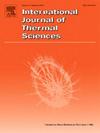磁等离子体动力推力器高热负荷曲面的湍流拓扑优化热结构设计
IF 4.9
2区 工程技术
Q1 ENGINEERING, MECHANICAL
International Journal of Thermal Sciences
Pub Date : 2025-06-16
DOI:10.1016/j.ijthermalsci.2025.110037
引用次数: 0
摘要
近十年来,随着空间推进技术的兴起,磁等离子体动力推进器(MPDT)因其更强的性能而受到青睐。然而,相当一部分电能在阳极以热量的形式耗散,导致温度过高,降低了螺旋桨的性能。为了缓解这种情况,液冷系统是必要的。本研究采用k-ε湍流拓扑优化方法设计了一种新型的MPD推进器高热负荷曲面冷却通道,并通过数值模拟和实验验证了其对热工性能的改善。我们研究了权重因素和不同目标函数对拓扑优化设计结果的影响,认为耗散和温度平均的多目标优化组合更为合适。当进口速度为0.7 m/s时,拓扑优化设计使流道压降降低11.3% ~ 16.2%,热阻降低0.0037 ~ 0.0054 W/K,努塞尔数比传统设计提高35.5% ~ 84.1%。该研究为采用湍流拓扑优化方法设计高雷诺数高热负荷表面下的通道提供了指导。考虑到加工难度和热液特性,对ToA,6模型进行了加工和实验测试,实验结果与数值模拟结果吻合较好。本文章由计算机程序翻译,如有差异,请以英文原文为准。
Turbulent topology optimized thermal structure design for curved surfaces with high heat loads in MagnetoPlasmaDynamic Thrusters
In the past decade, with the rise of space propulsion, MagnetoPlasmaDynamic Thrusters(MPDT) have been favored due to their stronger performance. However, a considerable part of the electrical energy is dissipated in the form of heat at the anode, resulting in excessive temperature, which reduces the performance of the propeller. In order to alleviate this situation, liquid cooling system is necessary.
This study designed a new cooling channel using the k-ε turbulence topology optimization method for the high heat load curved surface of the MPD thruster,and demonstrated the improvement of thermal hydraulic performance through numerical simulation and experiments. We have studied the influence of weight factors and different objective functions on the results of topology optimization design, and believe that the multi-objective optimization combination of dissipation and temperature averaging is more appropriate. When the inlet velocity is 0.7 m/s, topology optimization design reduces the pressure drop of the flow channel by 11.3 %–16.2 %, reduces the thermal resistance by 0.0037–0.0054 W/K, and increases the Nusselt number by 35.5 %–84.1 % compared to traditional design. This study provides guidance for channel design under high heat load surfaces at higher Reynolds numbers using turbulent topology optimization methods.
Considering the machining difficulty and the thermo-hydraulic properties, the ToA,6 model were fabricated and machined and tested experimentally, and the experimental results were in agreement with the numerical simulations.
求助全文
通过发布文献求助,成功后即可免费获取论文全文。
去求助
来源期刊

International Journal of Thermal Sciences
工程技术-工程:机械
CiteScore
8.10
自引率
11.10%
发文量
531
审稿时长
55 days
期刊介绍:
The International Journal of Thermal Sciences is a journal devoted to the publication of fundamental studies on the physics of transfer processes in general, with an emphasis on thermal aspects and also applied research on various processes, energy systems and the environment. Articles are published in English and French, and are subject to peer review.
The fundamental subjects considered within the scope of the journal are:
* Heat and relevant mass transfer at all scales (nano, micro and macro) and in all types of material (heterogeneous, composites, biological,...) and fluid flow
* Forced, natural or mixed convection in reactive or non-reactive media
* Single or multi–phase fluid flow with or without phase change
* Near–and far–field radiative heat transfer
* Combined modes of heat transfer in complex systems (for example, plasmas, biological, geological,...)
* Multiscale modelling
The applied research topics include:
* Heat exchangers, heat pipes, cooling processes
* Transport phenomena taking place in industrial processes (chemical, food and agricultural, metallurgical, space and aeronautical, automobile industries)
* Nano–and micro–technology for energy, space, biosystems and devices
* Heat transport analysis in advanced systems
* Impact of energy–related processes on environment, and emerging energy systems
The study of thermophysical properties of materials and fluids, thermal measurement techniques, inverse methods, and the developments of experimental methods are within the scope of the International Journal of Thermal Sciences which also covers the modelling, and numerical methods applied to thermal transfer.
 求助内容:
求助内容: 应助结果提醒方式:
应助结果提醒方式:


